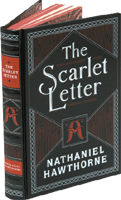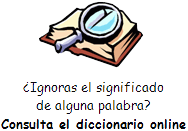HESTER AT HER NEEDLE
Hester Prynne, therefore, did not flee. On the outskirts of the
town, within the verge of the peninsula, but not in close vicinity
to any other habitation, there was a small thatched cottage. It had
been built by an earlier settler, and abandoned, because the soil
about it was too sterile for cultivation, while its comparative
remoteness put it out of the sphere of that social activity which
already marked the habits of the emigrants. It stood on the shore,
looking across a basin of the sea at the forest-covered hills,
towards the west. A clump of scrubby trees, such as alone grew on
the peninsula, did not so much conceal the cottage from view, as
seem to denote that here was some object which would fain have been,
or at least ought to be, concealed. In this little lonesome dwelling,
with some slender means that she possessed, and by the licence of
the magistrates, who still kept an inquisitorial watch over her,
Hester established herself, with her infant child. A mystic shadow
of suspicion immediately attached itself to the spot. Children, too
young to comprehend wherefore this woman should be shut out from the
sphere of human charities, would creep nigh enough to behold her
plying her needle at the cottage-window, or standing in the doorway,
or labouring in her little garden, or coming forth along the pathway
that led townward, and, discerning the scarlet letter on her breast,
would scamper off with a strange contagious fear.
Lonely as was Hester's situation, and without a friend on earth who
dared to show himself, she, however, incurred no risk of want. She
possessed an art that sufficed, even in a land that afforded
comparatively little scope for its exercise, to supply food for her
thriving infant and herself. It was the art, then, as now, almost
the only one within a woman's grasp—of needle-work. She bore on her
breast, in the curiously embroidered letter, a specimen of her
delicate and imaginative skill, of which the dames of a court might
gladly have availed themselves, to add the richer and more spiritual
adornment of human ingenuity to their fabrics of silk and gold. Here,
indeed, in the sable simplicity that generally characterised the
Puritanic modes of dress, there might be an infrequent call for the
finer productions of her handiwork. Yet the taste of the age,
demanding whatever was elaborate in compositions of this kind, did
not fail to extend its influence over our stern progenitors, who had
cast behind them so many fashions which it might seem harder to
dispense with.
Public ceremonies, such as ordinations, the installation of
magistrates, and all that could give majesty to the forms in which a
new government manifested itself to the people, were, as a matter of
policy, marked by a stately and well-conducted ceremonial, and a
sombre, but yet a studied magnificence. Deep ruffs, painfully
wrought bands, and gorgeously embroidered gloves, were all deemed
necessary to the official state of men assuming the reins of power,
and were readily allowed to individuals dignified by rank or wealth,
even while sumptuary laws forbade these and similar extravagances to
the plebeian order. In the array of funerals, too—whether for the
apparel of the dead body, or to typify, by manifold emblematic
devices of sable cloth and snowy lawn, the sorrow of the survivors—there
was a frequent and characteristic demand for such labour as Hester
Prynne could supply. Baby-linen—for babies then wore robes of state—afforded
still another possibility of toil and emolument.
By degrees, not very slowly, her handiwork became what would now
be termed the fashion. Whether from commiseration for a woman of so
miserable a destiny; or from the morbid curiosity that gives a
fictitious value even to common or worthless things; or by whatever
other intangible circumstance was then, as now, sufficient to bestow,
on some persons, what others might seek in vain; or because Hester
really filled a gap which must otherwise have remained vacant; it is
certain that she had ready and fairly requited employment for as
many hours as she saw fit to occupy with her needle. Vanity, it may
be, chose to mortify itself, by putting on, for ceremonials of pomp
and state, the garments that had been wrought by her sinful hands.
Her needle-work was seen on the ruff of the Governor; military men
wore it on their scarfs, and the minister on his band; it decked the
baby's little cap; it was shut up, to be mildewed and moulder away,
in the coffins of the dead. But it is not recorded that, in a single
instance, her skill was called in to embroider the white veil which
was to cover the pure blushes of a bride. The exception indicated
the ever relentless vigour with which society frowned upon her sin. |
|
|
|
ESTER AGUJA EN MANO
Por consiguiente Ester no se movió de allí. En los lindes de la
población, aunque no en la vecindad inmediata de ninguna morada,
había una choza o cabaña, construida por uno de los primeros
colonos, y abandonada porque la tierra era demasiado estéril para el
cultivo. Su aislamiento y distancia de la población, la ponían fuera
del círculo de la actividad social que ya se notaba en las
costumbres de los colonos. Aquella pequeña habitación estaba a
orillas del mar, medio oculta por un bosquecillo de árboles no muy
corpulentos; y en ese lugar solitario, con los pocos recursos que
poseía, y gracias al permiso de los magistrados que aun ejercían una
especie de vigilancia inquisitorial sobre Ester, se instaló ésta con
su niñita. Inmediatamente se asoció a aquel lugar una vaga idea de
algo misterioso y desconocido. Los niños, demasiado tiernos para
comprender por qué aquella mujer se encontraba separada del resto de
sus semejantes, se arrastraban lo más cerca posible para verla
ocupada con su aguja sentada a la ventana de su cabaña, o de pie a
la puerta de la misma, o trabajando en el jardincito, o paseándose
en el sendero que conducía a la población; y al contemplar la letra
escarlata en el seno de su vestido, emprendían la carrera con un
temor extraño y contagioso.
Á pesar de lo solitario de la situación de Ester, y aunque no tenía
un amigo en la tierra que se atreviese a visitarla, no corría sin
embargo el riesgo de padecer escaseces. Poseía un arte que bastaba
para proporcionarle el sustento a ella y a su hijita, aun en un país
que ofrecía comparativamente pocas oportunidades para su ejercicio.
Arte que en aquella época, como hoy, era casi el único que estuviera
al alcance de la mujer,—la costura. Llevaba en el seno, en la letra
primorosamente bordada, una muestra de su habilidad delicada y de su
inventiva, de que se habrían alegrado las damas mismas de la Corte
poder aprovecharse para agregar a sus ricas telas de seda y oro los
adornos aun más preciados del arte humano.
Cierto es que, dada la sencillez del traje negro que caracterizaba
en lo general las modas puritanas de aquel tiempo, no se
presentarían muchas ocasiones en que pudiera desplegar Ester sus
talentos con la aguja; sin embargo, el gusto de la época que se
complacía en lo que era complicado en esta clase de trabajos, no
pudo menos de ejercer su influencia en aquellos severos puritanos,
nuestros antepasados, que se habían desprendido de tantas cosas que
hoy nos parecen muy difíciles de renunciar. Las ceremonias públicas,
tales como la instalación de magistrados, y cuanto pudiera agregar
majestad al modo con que un nuevo gobernador se presentaba al
pueblo, se distinguían por un ceremonial imponente y una sombría
pero estudiada magnificencia. Grandes cuellos o lechuguillas, fajas
de intrincadas labores, y guantes lujosamente bordados, eran de
absoluta necesidad para los altos funcionarios al hacerse cargo de
las riendas del poder; y su uso se permitía también a los individuos
distinguidos por su posición o riqueza, aunque las leyes suntuarias
prohibían estos y otros lujos semejantes a los plebeyos. En los
funerales, ya en el vestido del difunto, o ya para expresar por
variedad de signos emblemáticos de paño negro y linón blanco el
dolor de los sobrevivientes, había también una demanda frecuente de
la clase de labor que Ester podía suministrar. Los pañales y
faldellines para niños, pues en aquella época los niños de tierna
edad llevaban vestidos de gala, ofrecían también ocasión para
labores delicadas de aguja.
Poco a poco, aunque no con mucha lentitud, los trabajos de Ester se
fueron haciendo de moda, como hoy se dice, ya por compasión hacia
una mujer cuyo destino había sido tan desgraciado, ya por la mórbida
curiosidad que da un valor ficticio a cosas comunes o que no tienen
ninguno, ya porque entonces, como ahora, se concediera a ciertas
personas, por cualquiera razón, lo que otros solicitan en vano, o
porque Ester llenara realmente un vacío que se dejaba sentir; es lo
cierto que halló frecuente empleo para su aguja, y bien remunerado.
Tal vez la vanidad escogió, como medio de mortificarse, llevar a las
pompas y ceremonias del Estado los adornos labrados por sus manos
pecadoras. Veíase su labor en los cuellos del Gobernador; los
militares la mostraban en sus bandas y fajas; el ministro del altar
también dejaba verla en su traje severo; adornaba el gorrito de los
recién nacidos, y hasta los ataúdes de los que llevaban a enterrar.
Pero no se recuerda un solo caso en que la habilidad de Ester se
solicitase para bordar el velo blanco que debía de cubrir el rostro
pudoroso de una novia conducida al altar. Esta excepción indicaba lo
inextinguible del rigor con que la sociedad reprobaba su pecado. |





